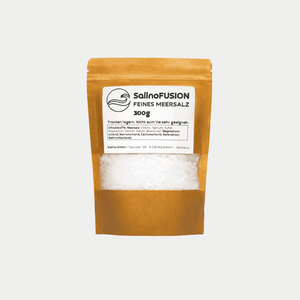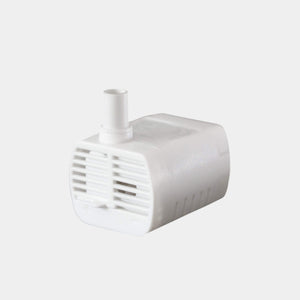The quiet desire for another home
It doesn't start with the piece of furniture. Nor with a green electricity tariff or an organic paint job. It begins with a feeling – elusive, but familiar. The feeling that something is no longer right within our own four walls. That we have too much, live too fast, and breathe too rarely.
Sustainable living means more than ecological insulation or eliminating plastic. It's a process that begins within. Within us. And then slowly extends into what surrounds us. Into what we touch, breathe, and look at as the day begins.
This article is an invitation to rethink, to circulate. It shows why sustainable living begins with the air. How spaces become quieter when we pack less into them. And how even small, almost invisible changes—like the mini-saltworks—can be part of a new everyday life.
When rooms not only warm but heal
The forgotten dimension of living: Air as a living space
 We don't notice it as long as it's functioning. And yet it is the invisible carrier of our well-being: air. 20,000 breaths a day. Each of them is an exchange with our environment. Those who want to live sustainably don't start with the wall color – but with the indoor climate.
We don't notice it as long as it's functioning. And yet it is the invisible carrier of our well-being: air. 20,000 breaths a day. Each of them is an exchange with our environment. Those who want to live sustainably don't start with the wall color – but with the indoor climate.
We spend most of our time indoors these days. Yet, few topics are as neglected as the quality of that air. Particulate matter, fumes, dry air from heating systems – all of these things affect our health, often without us noticing. The first step toward sustainability is therefore a quiet one: ventilate, humidify, and clean – but without chemicals and without large electrical appliances.
This is where new solutions come into play. Devices like the mini-saltworks operate quietly and passively – without any filters, fragrances, or apps. Their principle is ancient: salt. It has been used for centuries to relieve respiratory problems. In this small, sustainably produced version, it brings the idea of the graduation tower back into everyday life. No wasted electricity, no noise, but with impact.
Material questions are also attitude questions
 Sustainability isn't visible until you feel it. In a warm wooden surface. In textiles that don't smell because they're not made of plastic. In furniture that's allowed to age rather than break prematurely. Filling your home with natural materials not only changes the look but also the atmosphere.
Sustainability isn't visible until you feel it. In a warm wooden surface. In textiles that don't smell because they're not made of plastic. In furniture that's allowed to age rather than break prematurely. Filling your home with natural materials not only changes the look but also the atmosphere.
Clay regulates humidity. Wood insulates and soothes. Cork insulates and lives with the environment. It's these subtle qualities that make spaces healthy – not the certification on the packaging. A sustainable home is a breathing system. And keeping air permeable also makes oneself more permeable – for peace, for clarity, for breathing.
Energy flows – and we can learn to direct it
Sustainability is not a technique, but a decision
When it comes to sustainable living, many people immediately think of solar panels, smart heating, or heat pumps. And yes, all of these have their place. But real change often begins much more subtly. The question: Do I really need the lights on? Do I need an electric aroma lamp—or is it simply the dry air giving me a headache?
Technology can help, but it doesn't replace awareness. Sustainability thrives on observation. On routines that don't consume more energy than necessary. On eliminating things that are no longer good for us. This could be a dehumidifier. A fan. Or simply getting into the habit of regularly tilting windows – even in winter, but deliberately.
Some devices make this easier. The mini-saltwater system, for example, requires no controls, no maintenance, and no electricity in the traditional sense. It's there. Reliable. Quiet. And in its simplicity, it's perhaps the most modern way to rethink technology—as a silent contribution to indoor health, not as another electronic element.
Heat stays where it is wanted
Saving energy doesn't mean freezing. It means understanding how heat behaves. How it escapes – through windows that don't close properly, through curtains that are too thin, through floors that are colder than the room. If you want to live in a climate-friendly way, you don't have to remodel. Often, just using the right materials in the right place is enough.
Wool curtains, natural fiber carpets, and wall paints with insulating properties—this isn't magic, but applied intelligence. And it goes even further: Avoiding overheating rooms not only saves CO₂ but also protects the indoor climate. Dry heating air is often the starting point for many ailments: irritated mucous membranes, poor sleep, and increased susceptibility to infection.
This is where passive humidification with saline solution can make all the difference. The Mini Saline works precisely with this idea – no fan, no ultrasound, but with impact. For allergy sufferers, for children's rooms, for anyone who wants to sleep better at night. Sustainability sometimes begins with what you can't hear – but still feel.
Less stuff, more home – a new approach to possessions
Possession that leaves space
A room can be large – and still feel cramped. Not because of the square footage, but because of the things that have accumulated in it. Sustainable living doesn't mean getting rid of everything. It means making more conscious choices. And recognizing that less doesn't mean empty, but rather light.
The things that last should be more than just pretty. They should have meaning. A story. A function. Or, ideally, both. Like a chair made from recycled wood. Or an object like the mini saltworks, which doesn't scream, but is there. Unobtrusive on a shelf. But with impact – for the air, for well-being, for everyday life.
Minimalism isn't a style. It's a dialogue with the essential. And it asks: What remains when everything superfluous goes? Often, it's just three or four things – a table you enjoy sitting at. A light that doesn't dazzle. And perhaps a device that quietly does what you can't see: change the quality of the room.
Interior design as an attitude, not as a trend
The sustainable home isn't "Scandinavian," "boho," or "clean." It's simply authentic . Materials are tangible, not coated. Textiles are allowed to wrinkle. Colors are allowed to fade. Nothing is perfect, but everything has a reason to be there.
This attitude also extends to the choice of technical aids. Instead of smart air purifiers with replaceable filters and app control, a simple, maintenance-free solution is often sufficient. The mini salt plant is one such example: not a plastic cabinet with a touchscreen, but a quiet element that simply does what it's supposed to – add salt to the air. For people who long for a natural climate, not for new features.
Sustainable furnishing doesn't begin in a catalog, but in the mind. And it doesn't end with the purchase—it ends with the feeling that a room suddenly feels right.
Conclusion: When spaces heal – sustainable living as a return to ourselves
 Sustainability doesn't begin with a purchase. It begins with an attitude. With the desire to live differently—more calmly, healthily, more mindfully. Those who change their homes often change with them. Rooms become clearer, air becomes more tangible, possessions take on more weight—because we no longer collect, but rather select.
Sustainability doesn't begin with a purchase. It begins with an attitude. With the desire to live differently—more calmly, healthily, more mindfully. Those who change their homes often change with them. Rooms become clearer, air becomes more tangible, possessions take on more weight—because we no longer collect, but rather select.
Sustainable living means taking the world seriously in its smallest details. Not wasting light. Valuing materials. Using technology where it's useful—not where it's just a nuisance. Those who choose conscious design, a chemical-free indoor climate, and products that give more than they take are taking a path that doesn't have to be perfect. But it's honest.
One example of this is quiet solutions like the Mini-Saline: a small, salt-based air module developed for a better indoor climate – without electricity consumption, without filter changes, without effort. It's no miracle, but one of the many small decisions that can turn a room into a home.
Because sustainable living isn't a technique. It's a feeling. And perhaps that's precisely the beginning—not for the home, but for the life in it.



